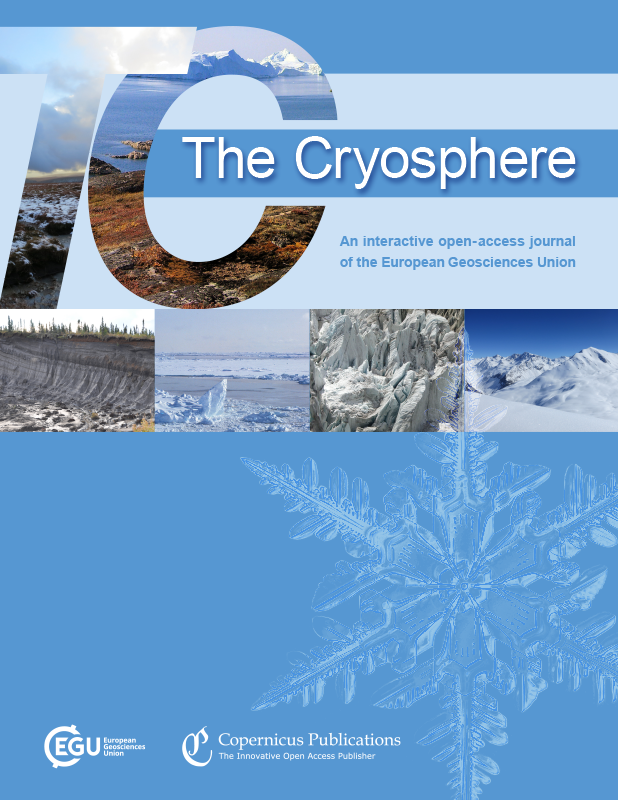Sentinel-1合成孔径雷达图像中海冰类型的分类
IF 4.2
2区 地球科学
Q1 GEOGRAPHY, PHYSICAL
引用次数: 40
摘要
摘要提出了一种新的基于Sentinel-1图像的海冰分类算法,该算法使用在半自动机器中训练的基于机器学习的模型来支持日常的冰图绘制。以前的研究主要集中在选择训练和验证数据的手工工作上。我们表明,来自运营冰服务的现成冰图可以减少准备大量训练/测试数据的人工工作量。此外,他们可以通过间接利用海冰专家在操作冰服务中的最佳能力,向培训师提供高度可靠的数据。拟议方案分为两个阶段:培训和运作。这两个阶段都始于从Sentinel-1数据中去除热噪声、扇形噪声和纹理噪声,以及计算滑动窗口中的灰度共生矩阵和Haralick纹理特征。在训练阶段,每周的冰图被重新投影到SAR图像几何结构中。利用输入上的纹理特征和来自输出的光栅化冰图的标签来训练随机森林分类器。然后,将训练好的分类器直接应用于Sentinel-1图像的纹理特征。对弗拉姆海峡和巴伦支海冬季(1-3月)和夏季(6-8月)两个数据集的测试结果表明,该分类器能够检索到三种广义覆盖类型(开放水域、混合一年冰和旧冰),总体准确率为87 % 和67 % 分别在冬季和夏季。在夏季,分类仪未能区分第一年的混合冰和旧冰,准确率仅为12 %; 然而,它的表现相当像一个冰水鉴别器,精度高达98 % 因为混合的第一年冰和旧冰之间的错误分类介于两者之间。五种覆盖类型(开放水域、新冰、年轻冰、一年冰和旧冰)在冬季的准确度为60 %. 这些错误既归因于冰图上不正确的人工分类,也归因于半自动算法。最后,我们使用每日镶嵌的Sentinel-1图像展示了冰图近实时服务的潜力。本文章由计算机程序翻译,如有差异,请以英文原文为准。
Classification of sea ice types in Sentinel-1 synthetic aperture radar images
Abstract. A new Sentinel-1 image-based sea ice classification
algorithm using a machine-learning-based model trained in a semi-automated
manner is proposed to support daily ice charting. Previous studies mostly
rely on manual work in selecting training and validation data. We show that
the readily available ice charts from the operational ice services can
reduce the amount of manual work in preparation of large amounts of
training/testing data. Furthermore, they can feed highly reliable data to
the trainer by indirectly exploiting the best ability of the sea ice experts
working at the operational ice services. The proposed scheme has two phases:
training and operational. Both phases start from the removal of thermal,
scalloping, and textural noise from Sentinel-1 data and calculation of grey
level co-occurrence matrix and Haralick texture features in a sliding
window. In the training phase, the weekly ice charts are reprojected into
the SAR image geometry. A random forest classifier is trained with the
texture features on input and labels from the rasterized ice charts on
output. Then, the trained classifier is directly applied to the texture
features from Sentinel-1 images operationally. Test results from the two
datasets spanning winter (January–March) and summer (June–August) seasons acquired
over the Fram Strait and the Barents Sea showed that the classifier is
capable of retrieving three generalized cover types (open water, mixed
first-year ice, old ice) with overall accuracies of 87 % and 67 % in
winter and summer seasons, respectively. For the summer season, the classifier
failed in distinguishing mixed first-year ice from old ice with accuracy of
only 12 %; however, it performed rather like an ice–water discriminator
with high accuracy of 98 % as the misclassification between the mixed
first-year ice and old ice was between them. The accuracy for five cover
types (open water, new ice, young ice, first-year ice, old ice) in the winter
season was 60 %. The errors are attributed both to incorrect manual
classification on the ice charts and to the semi-automated algorithm.
Finally, we demonstrate the potential for near-real-time service of the ice
map using daily mosaicked Sentinel-1 images.
求助全文
通过发布文献求助,成功后即可免费获取论文全文。
去求助
来源期刊

Cryosphere
GEOGRAPHY, PHYSICAL-GEOSCIENCES, MULTIDISCIPLINARY
CiteScore
8.70
自引率
17.30%
发文量
240
审稿时长
4-8 weeks
期刊介绍:
The Cryosphere (TC) is a not-for-profit international scientific journal dedicated to the publication and discussion of research articles, short communications, and review papers on all aspects of frozen water and ground on Earth and on other planetary bodies.
The main subject areas are the following:
ice sheets and glaciers;
planetary ice bodies;
permafrost and seasonally frozen ground;
seasonal snow cover;
sea ice;
river and lake ice;
remote sensing, numerical modelling, in situ and laboratory studies of the above and including studies of the interaction of the cryosphere with the rest of the climate system.
 求助内容:
求助内容: 应助结果提醒方式:
应助结果提醒方式:


